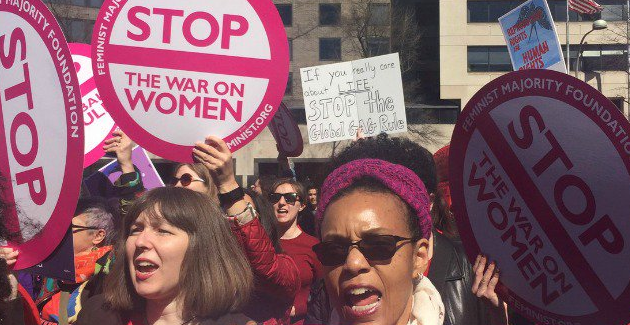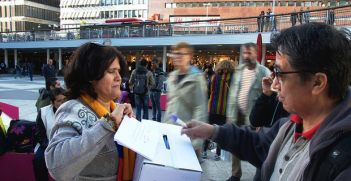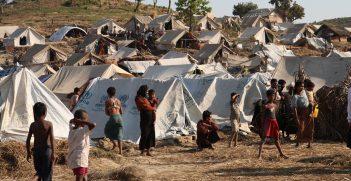The Global Gag Rule Will Harm International Security

The recently reinstated US Global Gag Rule will have far-reaching consequences for women’s health and gender equality. The ongoing imbalance prevents effective long-term solutions to conflict.
In January 2017, US President Donald Trump reinstated the Mexico City policy, more commonly known to its opponents as the ‘Global Gag Rule’ (GGR). The policy places limits on US funding to overseas non-government organisations (NGOs) that perform or promote abortion services. The policy originated under the Reagan administration and was spurred by the 1984 World Population Conference held in Mexico City. Since its introduction in 1984, it has been rescinded or reinstated based on party lines. The policy was revoked under Democrats Barack Obama and Bill Clinton, and reinstated under the Republican presidencies of George H.W. Bush and George W. Bush.
The effects of the GGR are far reaching. The policy primarily affects NGOs from the global south, those that are most reliant on foreign aid and will be forced to comply with the rule or risk losing funding. This is particularly concerning as the US continues to be one of the largest donor countries for international family planning assistance and humanitarian aid. NGOs are also effectively prohibited from performing abortion-related work using their non-US funds, even in countries where abortion is legal. In addition, US-based NGOs are indirectly affected because they are prevented from implementing US aid development programs and other related partnerships with overseas NGOs unless they are GGR eligible.
The rule will be disproportionately detrimental to women and girls in the global south. It undermines the basis for bodily autonomy and integrity by denying the availability of comprehensive sexual and reproductive health and rights (SRHR). Of equal importance, the reinstatement of the GGR runs counter to achieving key goals reflected in international security and development agendas such as the Women, Peace and Security agenda and the 2030 Sustainable Development Goals.
The final report on the Millennium Development Goals noted that the fifth goal, ‘Improving Maternal Health’, remains unfinished largely due to the slow progress in stemming maternal deaths in the global south. Adolescent fertility rates are overwhelmingly high at 96 per cent in low-income countries compared to 13 per cent in high-income countries. Adolescent pregnancy severely curtails the capacity of girls to pursue education and therefore also limits their ability to achieve full political and economic participation. Girls that are forced into motherhood before their bodies are physically able to cope with the strain of childbirth have heightened health risks. One in 40 women from poor countries dies from pregnancy or childbirth complications, compared to one in 6000 in high-income countries. The high concentration of such deaths reveals global inequalities in resource distribution mediated not just by gender hierarchies but also by class, race, ethnicity, religion, age and sexuality.
Global health inequalities, especially for SRHR, remain unmatched by foreign aid allocations and public health expenditures. The World Health Organization notes that while for many countries there is a need to mobilise and effectively use domestic resources, “only an increased and predictable flow of donor funding will allow them to meet basic health needs in the short to medium term.” The United Nations Population Fund has persistently called out the inadequate financial and political support for SRHR from developed countries in the face of worsening conditions for women in developing countries.
SRHR, unlike all other health components, remain deeply contested and constantly under threat of backsliding. The idea that sexual and reproductive health is fundamental to human dignity remains fiercely contested by religious groups and conservative governments at various levels of policymaking. As gender relations and development academic Deniz Kandiyoti observes, an underlying theme of many of the world’s prominent religions is “to establish the principle that matters relating to sexuality, to the control of female bodies, and to reproductive choice do not belong to the sphere of civic deliberation, public choice, or human rights but to a domain of non-negotiable morality defined by doctrinal imperatives.”
The 10 countries with the highest maternal mortality rates in the world are all affected by or are emerging from war. Over half of the world’s maternal deaths occur in conflict-affected states. Nonetheless, states have the responsibility under international human rights and humanitarian laws to progressively promote the health and wellbeing of all individuals.
Despite remarkable progress in targeting humanitarian services to women and girls over the past decade, large gaps remain beyond the crisis phase. According to the Stockholm International Peace Research Institute, global military expenditure in 2015 was an estimated US$1.7 trillion (AU$2.3 trillion). In the Asia-Pacific, military spending rose by 5.4 per cent in 2015 alone, and by 64 per cent between 2006 and 2015, reaching US$436 billion in 2015. Militarism diverts resources away from long-term prevention of violence strategies and sustainable development. It exacerbates neoliberal solutions such as fiscal austerity in response to economic crises, thereby depleting resources for health service delivery during and after crises.
The rise of religious fundamentalisms in tandem with neoliberal global economic processes may increasingly play a central role in legitimising gendered inequalities that manifest in the control of women’s bodies. Yet from a feminist perspective it is precisely these women and girls who are in the best position to promote comprehensive long-term solutions that attend to multidimensional experiences of insecurity, peace and development. Such a transformative project of gender inclusion, however, begins when women and girls take full control over their own bodies.
The reinstatement of the GGR also carries grave symbolic harms. As a form of restriction to sexual and reproductive freedoms globally, it was reinstated by the very same person who had also previously remarked that women who undergo abortion must be subjected to “some form of punishment” and confessed to grabbing women “by the pussy”.
However wrong this is, it is crucial not to lose sight of broader structural inequalities that perpetuate the progressive abrogation of SRHR in crisis situations and everyday life.
Maria Tanyag is a PhD candidate and research assistant at the School of Social Sciences at Monash University.
This is an abridged version of a longer article published by the AIIA’s national youth international affairs publication, Quarterly Access on 27 March 2017





